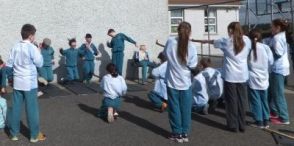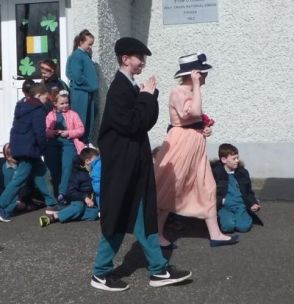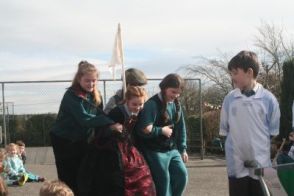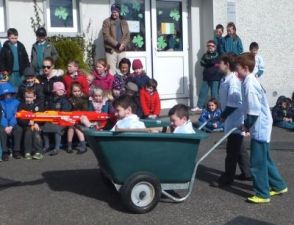1916 Commemoration
On Tuesday March 15th. every school in Ireland commemorated the Rebellion of 1916 by reading the proclamation and raising the Irish Flag. The pupils of Firoda N.S. went a step further and performed a re-enactment of the rising. The drama commenced with Roger Casements attempt to land 20,000 rifles and ammunition from a German ship called “The Aud” off the coast of Kerry on Good Friday. Roger was subsequently captured and taken to London where he was executed. On Easter Monday the Irish rebels occupied strategic positions around Dublin including the G.P.O., Bolands Mills and the Customs House. They read the proclamation in front of the G.P.O. and raised the Tricolour. Savage fighting ensued when the English soldiers arrived on the scene. The rebels held out for a few days but when the gunship “The Helga” sailed up the Liffey and opened fire with cannons, it spelled the beginning of the end for the rebels. When Padraig Pearse saw an innocent family, that was fleeing the fighting under a white flag, shot down by the British he instructed his soldiers to surrender. The rebels were marched to Kilmainham Gaol where the leaders were executed. Joseph Mary Plunkett was allowed marry his sweetheart, Grace Gifford, in prison on the night before his execution.
The Following is the narration that accompanied the Pageant:
On Easter Monday, April 24, 1916, a group of Irish nationalists proclaimed the establishment of the Irish Republic and, along with some 1,600 followers, staged a rebellion against the British government in Ireland. The rebels seized prominent buildings in Dublin such as the GPO, Bolands Mills, Liberty Hall and The Four Courts. They clashed with British troops. Within a week, the insurrection had been suppressed and more than 2,000 people were dead or injured. The leaders of the rebellion soon were executed. Initially, there was little support from the Irish people for the Easter Rising; however, public opinion later shifted and the executed leaders were hailed as martyrs. In 1921, a treaty was signed that in 1922 established the Irish Free State, which eventually became the modern-day Republic of Ireland.
- The rebels had arranged with the Germans for a large importation of arms to be delivered on Good Friday, April 21st, to Tralee bay in Co. Kerry on a ship called the AUD. Roger Casement was in charge of the shipment and travelled separately on a U-Boat to the rendezvous. However the AUD got delayed and Casement could not contact them. He attempted to land at nearby Banna Strand but his small boat overturned and he was captured by the British. When the AUD arrived they got no signal from the strand and dumped the guns. Roger was taken to London and executed.
- The rebellion commenced on Easter Monday 24th. April with the rebels taking over various locations in the City such as Liberty Hall and The Four Courts.
- A group led by Padraig Pearse and James Connolly marched down Sackville St. and took over the GPO. Shortly after, Pearse emerged from the building and read the proclamation, declaring Ireland a Republic. The British Flag was removed from the roof of the building and the Tricolour was raised.
- The British Soldiers quickly arrived and fighting broke out at the several locations occupied by the rebels. The fighting was fierce and many were killed on both sides.
- The Rebels held out for a few days. However when the British gunboat “The Helga” sailed up the Liffey and started firing it’s cannons on Bolands Mills and Liberty Hall it spelled the beginning of the end for the rebels.
- On Saturday 29th. April an innocent family tried to escape the fighting in Moore St. They were shot down, even though they were carrying a white flag. When Padraig Pearse saw this he decided that the rebels should surrender to avoid further bloodshed.
- When the Rebels surrendered they were marched under armed escort to Kilmainham Gaol. Many of the local people jeered the rebels as they did not agree with the “Rising” They were angry that their beautiful city of Dublin had been destroyed and many people killed.
- After the rising the Rebel leaders were tried, convicted of Treason and sentenced to death.
- Joseph Plunkett was allowed to marry his sweetheart Grace Gifford in Gaol just hours before his execution.
- Sometime during those days, Castlecomer man, Patrick Bealin was murdered on North King St. He was taking care of the pub where he worked for fear looters would raid it. The British soldiers broke in, took him to the cellar and shot him. He was one of about 17 innocent men murdered during those days.
- The rebel leaders were led out and placed against a wall in Kilmainham Gaol where they were shot. James Connolly was so badly injured that he had to be carried out to his execution and was shot while tied to a chair.
- Public opinion changed following the executions and all the rebels were declared Heroes by the people.
- As a direct result of the 1916 rising and brave actions by Irish Volunteers in the following years, Ireland was declared a Republic in 1922, gaining freedom from British Rule for 26 of it’s 32 counties. Hopefully in the not too distant future the remaining 6 Counties will also become part of the Republic of Ireland.








